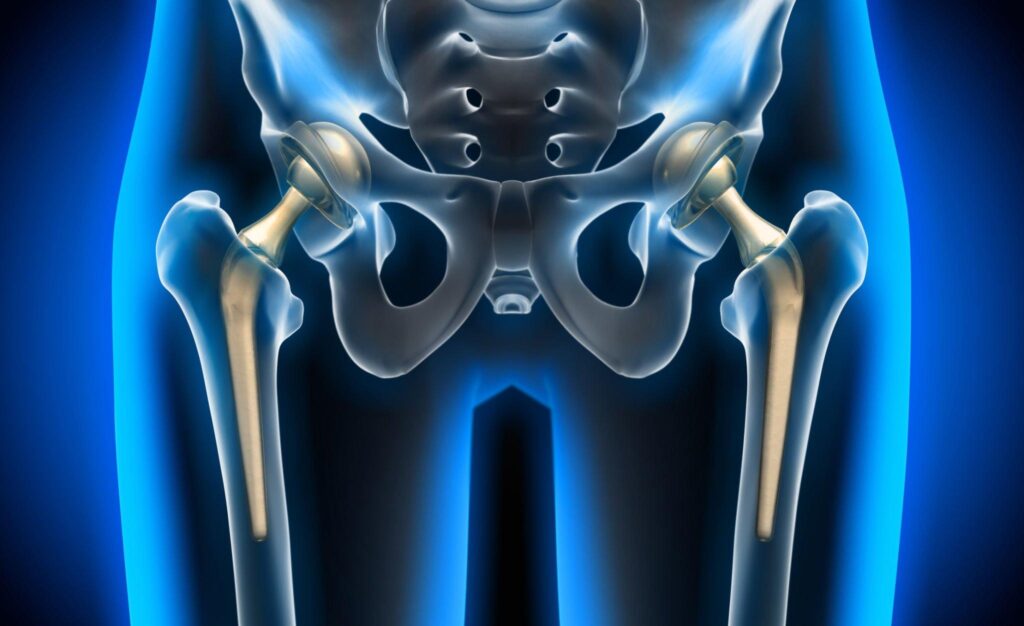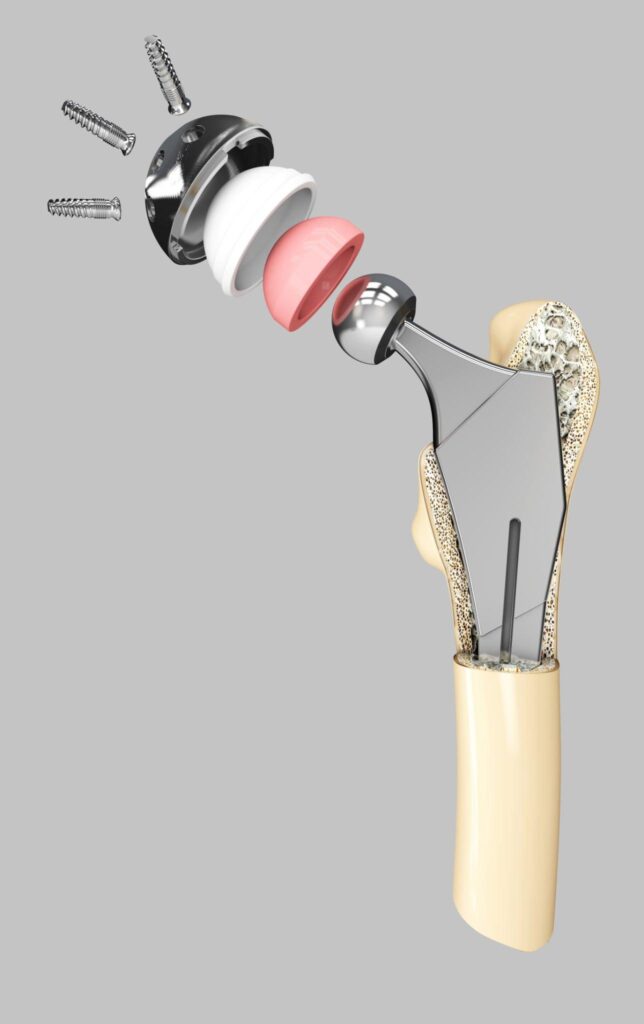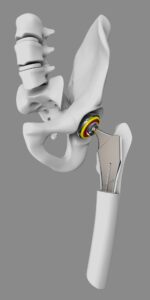Hip Replacement
- Home
- Services
Joint Replacement
Total Hip Replacement
One Of the Best Orthopaedic Doctor and Team In Ernakulam, Kerala
Why you need a Hip Replacement Surgery?
Hip replacement surgery was first performed in the year 1960 and is one of the most successful surgeries in the world of medicine. Since then the surgical techniques and technology have advanced tremendously. Hip replacement is usually done to relieve the symptoms of pain and restricted mobility for the patients in need. Hip replacement surgery is safe and effective procedure to relieve the pain and increase range of motion. The most common causes of hip pain needing total hip replacement are:
- Osteoarthritis: It is an age related wear and tear of the joint where there is destruction of the joint cartilage resulting in rubbing of the two bony surfaces causing pain and stiffness. This maybe accelerated by irregularities on the bony surfaces due to childhood disease.
- Rheumatoid arthritis: It is an autoimmune disease causing inflammation and thickening of the synovial membrane damaging the cartilage resulting in pain and stiffness. It is a progressive disease affecting multiple joints and can result in serious crippling of the patient if not managed at an early stage.
- Post traumatic arthritis: Results from injuries or fractures around the hip. Studies have shown the outcome of fracture neck of femur managed by total hip replacement to be better than hemiarthroplasty. Total hip replacement implants have a longer life and revision is easier when compared to bipolar hemiarthroplasty.
- Avascular necrosis: Results from reduced blood supply to the femoral head resulting in bone collapse and arthritis. The loss of articular surface results in destruction of the joint causing pain and severe restriction of movement.
- Childhood hip disease: Many infants and children have hip problems like dysplastic development of hip/Leg-Calve-Perthes disease/Slipped capital femoral epiphysis etc. These might be treated in childhood but the patients have a high chance to develop arthritis later in life.
Surgical procedure
In total hip replacement the damaged femoral head and acetabular cartilage is removed and replaced with a metal socket and a new femoral head. There are various surgical approaches to the hip and it is the surgeons choice to decide which suits him/her the best. The joint is reached and the capsule is incised and the joint is dislocated. The femoral head is excised and the acetabulum is smoothened. The femoral stem is prepared. The implants come in various sizes and the correct desired implant size is decided using trial implants. The implant of desired size is placed and the joint reduced and checked for stability. The joint capsule is reduced and the incision is closed in layers.
Types
There are three broad types of hip replacement
1.Cemented – Where bone cement is used for fixation of implants to the bone. This is especially useful in osteoprototic patients.
2.Uncemented – Uncemented implants fix to the bone by ingrowth of bones over the implants. They have less chance of implant loosening and is preferred in younger patients.
3.Hybrid – As the name suggests, the acetabular part is uncemented while the femoral part is cemented.
Materials
Metal on Metal – When socket and ball components are made of metal. The metal compound used are titanium/cobalt-chromium alloys/cobalt mixed metals. Metal on metal were banned due to release of toxic metal ions caused by wear and tear of the material.
Metal on Poly – The outer socket of the acetabular cup is metallic which is line by ultra high molecular weight polyethylene compound liner which in turn articulated with the femoral head which is also metal.
Ceramic on metal, ceramic on poly, ceramic on ceramic – Ceramic implants are less commonly used by surgeons. Ceramic on metal is rarely used and ceramic on ceramic caused clanking sounds in the joint during movement and is seldom used. Most commonly used is the ceramic on poly implant. Ceramic parts are more durable than their metal counterparts but ceramic components are said to be more fragile. However with the latest advancements, this trend is slowly shifting.
Preoperative investigations
There are a battery of investigations and criteria that a patient has to undergo before being posted for a total hip replacement case. Preoperative Xrays, muscle strength and mobility of the patient are some of the important factors determining the final outcome of the surgery. Pre anaesthetic check up is a must for any operation and the same has to be carried out before getting the fitness for surgery. The patient has to undergo a cardiological evaluation and a routine dental check up and urine analysis to rule out any source of infection in the body.
Postoperative protocol.
The patient is made to walk from post operative day 1 with assistance of a walker. Post operative pain is managed with intraop intraarticular injections which are a cocktail of anaesthetic drugs or via an epidural catheter. The patient is usually discharged by post operative day 3 and is trained to walk using a walker which has to be continued for 6 weeks. The patient may sometimes need physiotherapy for muscle strengthening which may have gotten atrophied due to the deformity/pain in the hip.
Expectations
The patient must have realistic expectations from the surgery and must understand the limitations of the surgery. The surgery only relieves the pain and increases the range of motion of the hip joint. The patient must take care to not put the implants under stress bu jogging/running/jumping as they may drastically reduce the life of the implant by increasing the wear and tear.
The replaced hip has some restriction of movement where in a patient is asked not to hyperflex the hip/ over adduct the operated limb/sit crossed leg as these positions increase the risk of chance of dislocation of the hip. Sometimes after hip replacement the patient may also feel one leg to be shorter/longer than the other. A shoe lift on the shorter leg can easily rectify this problem.
No matter the cause, the patient are massively benefited by a successful hip replacement surgery and drastically improves their quality of living.



FAQ
General Question
We help you clear up your doubts

Testimonial
See What Patients Saying

Entrepreneur
Lorem ipsum dolor sit amet, consectetur adipiscing elit, sed do eiusmod tempor incididunt ut labore et dolore magna aliqua

Manager
Lorem ipsum dolor sit amet, consectetur adipiscing elit, sed do eiusmod tempor incididunt ut labore et dolore magna aliqua

HR Manager
Lorem ipsum dolor sit amet, consectetur adipiscing elit, sed do eiusmod tempor incididunt ut labore et dolore magna aliqua

HR Manager
Book Now
Make An Appointment
Get Back On Track With Your Health – Schedule Your Appointment Today!
Opening Hours
- 08.00 AM - 20.00 PM
- 08.00 AM - 17.00 PM
- 09.00 AM - 17.00 PM
- 09.00 AM - 18.00 PM


Lorem ipsum dolor sit amet, consectetur adipiscing elit, sed do eiusmod tempor incididunt ut labore et dolore magna aliqua